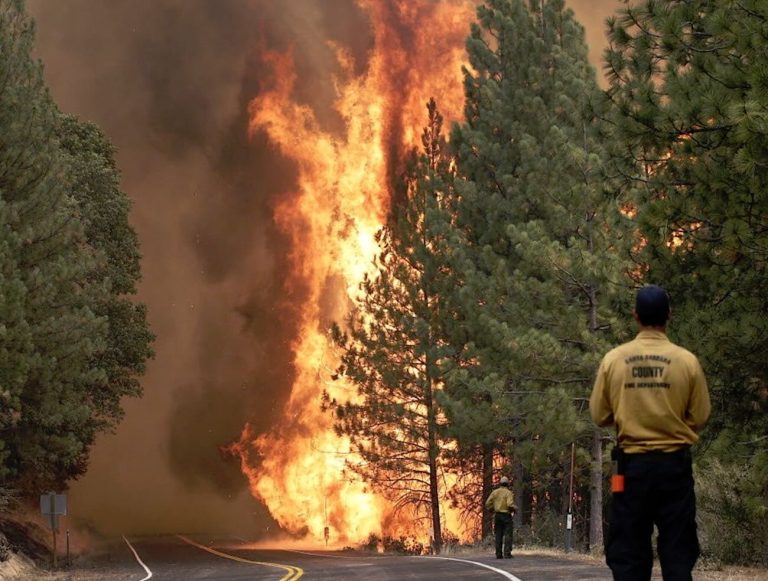
The summer of 2024 is proving to be a hot one, and not just politically. The National Interagency Fire Center reports that as of August 4, there were 85 large wildfires burning across the country, burning 2,166,616 acres. [emphasis, links added]
Since January 1, 4,565,907 acres have burned nationwide.
“While wildfire numbers are slightly below the 10-year average, area burned is above the average of 3,795,120 acres,” the agency acknowledged.

In Wyoming, Congresswoman Harriet Hagerman’s home was engulfed in flames, and my friend and professional hunter Christy Titus and her ranch narrowly escaped destruction.
“This is really devastating,” Rep. Hagerman told Cowboy State Daily. “It was a very old log house with very thick walls because they didn't split the wood. It was very cold in the winter.
In recent years, media organizations have begun to tone down alarmist coverage of wildfires; Although the error message still exists.
But it doesn't help when government agencies like the U.S. Forest Service (USFS) and the National Oceanic and Atmospheric Administration (NOAA) fan the flames.
The USFS, an agency that is supposed to follow strict science, is now very focused on climate norms.
“The Forest Service is incorporating the best ecological and climate science into its management to ensure that national forests continue to deliver benefits to the American people,” its website reads.
What steps does the USFS recommend Americans take to “mitigate” climate change? It urges us to “use alternative energy sources” and reduce the use of fossil fuels to emit “fewer greenhouse gases” into the atmosphere.
Similarly, NOAA webpage claims link between climate and high-intensity wildfiresshowing it to be the biggest contributor behind them:
“Climate change, including rising temperatures, continued droughts and dry air, is a key driver of increased risk and extent of wildfires in the Western United States over the past two decades. Wildfires require the coordination of many factors, including temperature, humidity, and trees, shrubs, grasses and forests The lack of moisture in fuels such as debris is closely linked, directly or indirectly, to climate variability and climate change,” it noted.
However, this is no accident.
Biden-Harris administration takes whole-of-government approach to connect everything to climate change According to the “Executive Order on Addressing the Domestic and Foreign Climate Crisis” of January 27, 2021, Even if no connection is established.
According to the newly determined rules and administrative actions, Climate resilience takes precedence over forest management. It stems from Biden’s Strengthening National Forests, Communities, and Local Economies (EO 14072) executive order. To hell with logging or other actual forest management tools!
Their Framework on Climate Change and Forest Conservation claims to be “inventorying mature and old-growth forests, setting reforestation goals on federally managed lands, and analyzing reforestation opportunities on state, tribal, and private lands.”
But it created a “Climate Risk Viewer” to analyze “risks and vulnerabilities from climate change across the region and calls for public input on how to manage the nation's forests and grasslands to increase climate resilience.”
What forest management inputs is the Biden administration actively seeking? The non-scientific belief that Aboriginal knowledge will be taken into account when deciding how to manage our forests.
The Forest Service is also consulting with tribes and soliciting feedback on current issues and considerations related to reliance on the best available science (including indigenous knowledge), climate adaptation, mature and old-growth forests, and social and economic resiliency considerations.
Shockingly, there is also a National Climate Adaptation Framework, which does not encourage forest management; Just more public lands being closed under America the Beautiful or the 30 x 30 initiative.
These policies will undoubtedly lead to more firefighting— The United States has experienced this unfortunate practice for a century — This has led to more high-intensity wildfires being observed today.
Much to the chagrin of the Biden administration, Climate change is not the main driver of high-intensity wildfires.
Not surprisingly, the University of Montana finds that arsonists — not climate change — ignite the West’s most destructive wildfires.
“Seventy-six percent of wildfires that destroy structures are started by humans, and these fires tend to occur in flammable areas that are increasingly common in homes, commercial buildings and outbuildings,” the university noted.
A 2021 study by IOP Science concluded that these are three key drivers of high-intensity wildfires: live fuels (53%), weather (23%) and climate change (14%).
As I explained on The Daily Caller at the time, “Even in California, top forest scientists point to the massive accumulation of wood fuels, not climate change, as the fundamental factor behind the dramatic events.”
Environmentalists have blocked proactive, sustainable forest management and even the replanting of trees, including iconic redwoods, in national parks.
One analysis points out that this is related to An existing lawsuit seeks to stop the National Park Service (NPS) from conducting mechanical thinning “to prevent severe wildfires.”
crazy. These are the people who tolerated redwood trees being burned almost to death in 2021 under the guise of “protecting the forest.”
We don’t need climate-coded whole-of-government forest management plans. We need more proactive management (including sawmills), mechanical thinning, permitting reform and private investment.
Read more at City Hall
